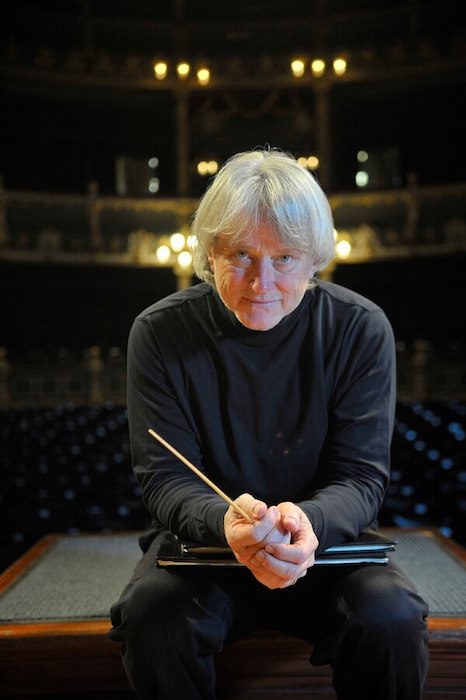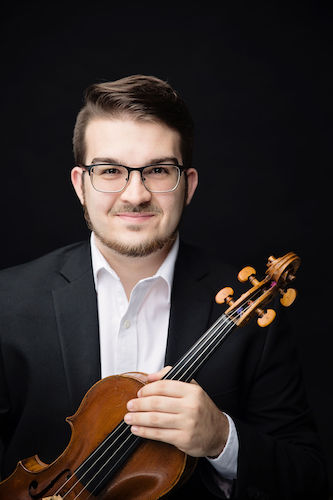St. Clair returns to lead Texas Music Festival musicians in high-energy concert

Carl St. Clair conducted the Texas Music Festival Orchestra Saturday night in Houston.
Texas Music Festival is in the midst of its 30th anniversary season, and the series celebrated a bit of its history Saturday night.
Carl St. Clair, music director of California’s Pacific Symphony and TMF’s most frequent podium guest, led the Festival Orchestra in the University of Houston’s Moores Opera House. In a second salute to the past, St. Clair opened the concert with a festival commission from 2005: David Heuser’s A Screaming Comes Across the Sky.
The title comes from the first sentence of Thomas Pynchon’s novel Gravity’s Rainbow. Heuser explains in his program note that the book’s central metaphor is the V-2 German rocket that pulverized London during World War II. The image behind Heuser’s six-minute score is not the blast of the missile’s impact, though, but the speed and momentum of its flight.
The result is a hard-driving toccata propelled by rapid-fire staccato themes and a chugging bass ostinato; a clontrastng lyrical line, perhaps evoking the rocket’s trajectory, weaves in occasionally. Even when the work’s middle section seems to grow calm, sotto voce bursts of percussion reveal that the headlong pace never really lets up.
St. Clair conducted the world premiere of A Screaming Comes Across the Sky 14 years ago, and he led a taut, dynamic performance Saturday. The orchestra played with bite and rat-a-tat precision. St. Clair and the orchestra gave the middle section a fuller, darker tone that may have hinted at the destructive power stored in the V-2’s warhead.
Hector Berlioz’s Symphonie fantastique let St. Clair and the players–young musicians at the college and graduate-school level–dig into another work animated by high-powered imagery. To help players and listeners alike get on its wavelength, festival general director Alan Austin read out Berlioz’s narrative program describing the lovelorn artist whose passions and torments come to life in this orchestral blockbuster.
The climax of the “Reveries and Passions” first movement flared up commandingly, thanks especially to the strings’ agility and the brasses’ gleam. But most of the movement sounded a bit too careful–not quite capturing the throb and fire of the music’s passions. The idée fixe theme describing the artist’s beloved didn’t have the stabs of intensity that can make it so potent, for instance.
It’s likely that some of the musicians were tackling Berlioz’s complex score for their first time, so that might explain some of the tentativeness. (Judging from how vigorously the players stamped their feet when St. Clair bowed at the end, they evidently appreciated his guidance.)
Berlioz’s tone-painting came across more vividly as the symphony unfolded. In “A Ball,” St. Clair not only set a buoyant, flowing pace for the waltz, but he led the strings to to produce an increasingly full and fervent tone. Including the optional part for cornet à pistons added flashiness, but the balance with the other winds sometimes went awry.
The full-throated English horn solo, echoed by the more-slender oboe offstage, helped establish the quiet intensity of “Scene in the Field.” When the rest of the orchestra entered, St. Clair guided it in spinning out Berlioz’s lyricism in swelling, ardent phrases. The lone English horn, whose fullness now gave way to plaintiveness, and the growing rumble of the kettledrums heralded the return of the hero’s loneliness.
The ferocity and abandon that St. Clair and the orchestra gave Heuser’s score returned in “March to the Scaffold” and “Dream of a Witches’ Sabbath.” The blaze of the brasses lent the march an ominous edge. And in the “Witches’ Sabbath,” St. Clair unleashed the full impact of the snarling brasses, shrieking strings and crashing percussion. The sneer of the woodwinds made the transformed idée fixe sound deliciously menacing, and the Dies irae chant became a ferocious dialogue between booming brasses and acid-tinged winds.

Brian Bires
The festival always gives a moment in the spotlight to an orchestra member who wins the annual concerto competition. This year’s victor was violist Brian Bires, a Maine native who recently earned a master’s degree from the University of Houston. He brought drama and expressiveness to the first movement of the Viola Concerto in G minor by Cecil Forsyth.
Written in 1903, the British composer’s concerto begins with a bang–a fortissimo, staccato orchestra chord that starts the viola ruminating–and develops into a sonorous, late-Romantic exchange between agitation and mellow lyricism.
Bires savored the contrasts between outbursts and introspection, and he captured the music’s restless energy as well as its tuneful poise. St. Clair made sure the orchestra backed up Bires discreetly when the viola led the way, then let the group lash out vigorously when Forsyth called for theatrics.
Conductor Josep Caballé-Domenech leads the Festival Orchestra in Gustav Mahler’s Symphony No. 6 at 7:30 p.m. Saturday in the University of Houston’s Moores Opera House. 713-743-3388, www.uh.edu/kgmca/music/tmf/


